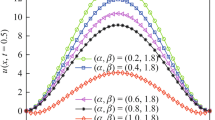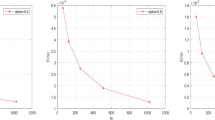Abstract
Recently, Zhang and Ding developed a novel finite difference scheme for the time-Caputo and space-Riesz fractional diffusion equation with the convergence order \({\mathcal {O}}(\tau ^{2-\alpha } + h^2)\) in Zhang and Ding (Commun. Appl. Math. Comput. 2(1): 57–72, 2020). Unfortunately, they only gave the stability and convergence results for \(\alpha \in (0,1) \;\;\mathrm {and} \;\; \beta \in \left[ {\frac{7}{8}+\frac{\root 3 \of {621+48\sqrt{87}}}{24}+\frac{19}{8\root 3 \of {621+48\sqrt{87}}}},2\right]\). In this paper, using a new analysis method, we find that the original difference scheme is unconditionally stable and convergent with order \({\mathcal {O}}(\tau ^{2-\alpha } + h^2)\) for all \(\alpha \in (0,1) \;\;\mathrm {and} \;\; \beta \in \left( 1,2\right]\). Finally, some numerical examples are given to verify the correctness of the results.
Similar content being viewed by others
Avoid common mistakes on your manuscript.
1 Introduction
In this paper, we consider the following time-Caputo and space-Riesz fractional diffusion equation:
where \(K>0\) is the diffusion coefficient. \(\,_{\text{C}}\mathrm {D}_{0,t}^\alpha u(x,t)\) is the Caputo fractional derivative with respect to t, of order \(0<\alpha <1\), defined by [4, 6, 7]
\(\displaystyle \frac{\partial ^\beta u(x,t)}{\partial |x|^\beta }\) is the Riesz fractional derivative with respect to x of order \(\beta \in (1,2]\), which is defined as [6,7,8]
where \(\,_{\text{RL}}\mathrm {D}_{a,x}^\beta\) denotes the left Riemann-Liouville fractional derivative
and \(\,_{\text{RL}}\mathrm {D}_{x,b}^\beta\) is the right Riemann-Liouville fractional derivative
Recently, Zhang and Ding [9] developed a novel finite difference scheme with convergence order \({\mathcal {O}}(\tau ^{2-\alpha } + h^2)\) for (1). However, it is a pity that they only proved that the stability and convergence in the case
based on the mathematical induction, while for case
it seems difficult to prove the result using their method.
In this article, we will use another analysis method to reanalyze the difference scheme established in [9] and find that it is unconditionally stable and convergent with order \({\mathcal {O}}(\tau ^{2-\alpha } + h^2)\) for all \(\beta \in (1,2]\) and \(\alpha \in (0,1)\).
The paper is organized as follows. In Sect. 2, we review the difference scheme established in [2] and its theoretical analysis. New stability and convergence analysis are introduced in Sect. 3. Numerical experiments are provided in Sect. 4 to prove the rationality of the theoretical analysis and the effectiveness of the algorithm.
2 Review the Algorithm in [9]
2.1 Establishment of the Algorithm
Define \(t_n=n\tau , n=0,1,\cdots ,N,\) and \(x_j=jh, \; j=0,1,\cdots ,M,\) where \(\tau =T/N\) and \(h=L/M\) are time and space mesh sizes, respectively.
For the numerical approximation of the Caputo fractional derivative \(\,_{\text{C}}\mathrm {D}_{0,t}^\alpha u(t)\) at \(t=t_n\;(n=0,1,\cdots ,N)\), the authors used the following common L1 formula [2, 5]:
where
At the same time, an effective second-order formula is used to numerically treat the spatial Riesz fractional derivative in [1], that is
where
and
Here, the coefficients
which can also be calculated by the following recursive relations [1]:
Next, substituting (2) and (3) into (1), we obtain
where there exists a constant C such that
Finally, omitting the high order terms \(R_j^n\) of (4). Replacing the function \(u(x_j,t_n)\) with its numerical approximation value \(u_j^n\), then we can obtain the following finite difference scheme [9]:
where \(q=\displaystyle \frac{\tau ^\alpha {\Gamma }(2-\alpha )K}{2h^\beta \cos \left( \frac{{\uppi} }{2}\beta \right) }\).
2.2 Theoretical Analysis of the Algorithm
Lemma 1
[1] Under the condition
the coefficient \(\displaystyle \kappa _{2,2}^{(\beta )}\) satisfies
In [9], by using mathematical induction, the stability and convergence results of the proposed scheme are stated as follows:
Theorem 1
Under the condition (6) and \(0<\alpha <1\), the finite difference scheme (5) for time-Caputo and space-Riesz fractional diffusion (1) is unconditionally stable.
Theorem 2
Denote by \(u(x_j,t_n)~(j=1,2,\cdots ,M-1;\; n=1,2,\cdots ,N)\) the exact solution of (1) at mesh point \((x_i,t_n)\), and let \(\{U_j^n\,|\,0\leqslant j\leqslant M, 0 \leqslant n\leqslant N\}\) be the solution of the finite difference scheme (5). Define
then there exists a positive constant C, such that
under the condition (6) and \(0<\alpha <1.\)
Remark 1
From the conclusion of the above two theorems, we find that the method in [9] can only prove that the difference scheme (5) is stable and convergent under the condition (6). Below, we will use another method to prove that the difference scheme (5) is unconditionally stable and convergent for all \(\alpha \in (0,1)\) and \(\beta \in (1,2]\).
3 A New Theoretical Analysis Method for the Algorithm in [9]
Let
be the space grid functions. For any \(u, v\in {\mathcal {U}}_h\), define the following inner product
and the corresponding norm
For convenience, denote the operator
then the numerical algorithm (5) can be rewritten as
where \(\mu =\tau ^\alpha {\Gamma }(2-\alpha )\).
Next, we list several lemmas for the stability and convergence analysis.
Lemma 2
[3] Let \(b_k=(k+1)^{1-\alpha }-k^{1-\alpha },~k=0,1,2,\cdots\) and \(0<\alpha <1\). Then there holds that
Lemma 3
[1] Let the operator \(\delta _x^{\beta }\) be defined by (7). Then the following inequality:
holds for all \(\beta \in (1,2].\)
Now, we give the stability result of the finite difference scheme (5).
Theorem 3
The finite difference scheme (5) is unconditionally stable to the initial value \(\varphi\) and right term f for all \(\alpha \in (0,1)\) and \(\beta \in (1,2]\).
Proof
Taking the inner product of the first equation of (8) with \(u^n\) leads to
For the second term of the left hand of (9), we obtain
based on the Cauchy-Schwarz inequality and Lemma 2.
Similarly, for the third term of the left hand of (9), we also have
For the first term of the right hand of (9), it follows from Lemma 3 that
As to the second term of the right hand of (9), we easily know that
Substituting (10), (11), (12) and (13) into (9) yields
Note that
and
then we obtain
Denote
then (14) can be rewritten as
Now, we will prove that
by the mathematical induction.
First of all, it is obviously true for \(n = 1\). Secondly, we assume that
is true for \(k=1,2,\cdots ,n-1.\) Then we can get further
that is
This ends the proof.
Finally, we consider the convergence of the difference scheme (5).
Theorem 4
Suppose that \(u(x_j,t_n)~(j=1,2,\cdots ,M-1; \; n=1,2,\cdots ,N)\) and \(\{u_j^n\,|\,0\leqslant j\leqslant M, 0 \leqslant n\leqslant N\}\) are the exact solution of (1) and finite difference scheme (5), respectively. Let
Then it holds that
for all \(\alpha \in (0,1)\) and \(\beta \in (1,2]\).
Proof
From (1) and (4), we obtain the following error equation:
For the first equation of (16), it follows from the inequality (15) that
Due to
then we get
This completes the proof.
4 Numerical Example
In this section, we give some numerical results to prove the rationality of our theoretical analysis.
Example 1
Consider the following equation:
with a given force term
Its exact solution is
By using the numerical algorithm (5), the maximum error, temporal convergence order and spatial convergence order were listed in Tables 1 and 2 for different values of \(\alpha ,\beta , \tau\) and h, respectively. From these tables, we can conclude that the developed numerical algorithm is unconditionally stable and convergent with order \({\mathcal {O}}(\tau ^{2-\alpha } + h^2)\).
In addition, Figs. 1, 2, 3 and 4 compare the graphs of the exact and approximate solutions with different values of \(\alpha\), \(\beta\), \(\tau\) and h. From these figures, we can conclude that the developed numerical solutions are in excellent agreement with the exact solution.
References
Ding, H.F., Li, C.P.: High-order numerical algorithms for Riesz derivatives via constructing new generating functions. J. Sci. Comput. 71, 759–784 (2017)
Langlands, T., Henry, B.: The accuracy and stability of an implicit solution method for the fractional diffusion equation. J. Comput. Phys. 205, 719–736 (2005)
Lin, Y., Xu, C.J.: Finite difference/spectral approximations for the time-fractional diffusion equation. J. Comput. Phys. 225, 1533–1552 (2007)
Liu, F., Zhuang, P., Anh, V., Turner, I., Burrage, K.: Stability and convergence of the difference methods for the space-time fractional advection-diffusion equation. Appl. Math. Comput. 191(1), 12–20 (2007)
Oldham, K.B., Spanier, J.: The Fractional Calculus. Academic Press, New York (1974)
Podlubny, I.: Fractional Differential Equations. Academic Press, San Diego (1999)
Shen, S., Liu, F., Anh, V.: Numerical approximations and solution techniques for the space-time Riesz-Caputo fractional advection-diffusion equation. Numer. Algorithms 56(3), 383–403 (2011)
Xu, T., Liu, F., Lu, S.: Finite difference/finite element method for two-dimensional time-space fractional Bloch-Torrey equations with variable coefficients on irregular convex domains. Comput. Math. Appl. 80(12), 3173–3192 (2020)
Zhang, Y., Ding, H.: Numerical algorithm for the time-Caputo and space-Riesz fractional diffusion equation. Commun. Appl. Math. Comput. 2(1), 57–72 (2020)
Author information
Authors and Affiliations
Corresponding author
Ethics declarations
Conflict of interest
On behalf of all authors, the corresponding author states that there is no conflict of interest.
Additional information
The work was partially supported by the National Natural Science Foundation of China (Nos. 11901057 and 11561060).
Rights and permissions
About this article
Cite this article
Tian, J., Ding, H. A Note on Numerical Algorithm for the Time-Caputo and Space-Riesz Fractional Diffusion Equation. Commun. Appl. Math. Comput. 3, 571–584 (2021). https://doi.org/10.1007/s42967-021-00139-0
Received:
Revised:
Accepted:
Published:
Issue Date:
DOI: https://doi.org/10.1007/s42967-021-00139-0








